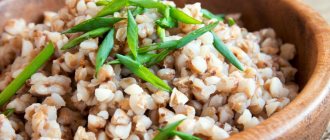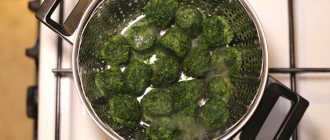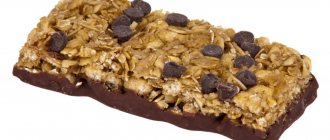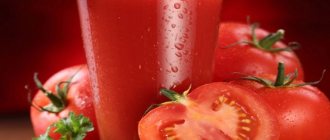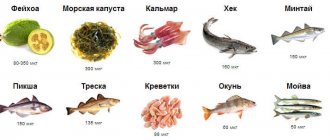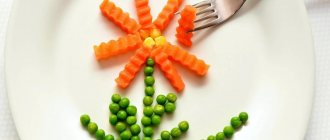Buckwheat stewed in vegetables
To prepare this dish you will need vegetables:
- zucchini, cut into small pieces - in the volume of two-thirds of a glass,
- bell pepper, cut into not very large strips - also two-thirds of a glass;
- celery stalk, chopped quite finely - about a quarter of a glass.
In addition to them, you need to prepare half a glass of buckwheat, a little vegetable oil and a glass of water. If desired, you can add grated Adyghe cheese in the amount of two-thirds of a glass.
Spices you will need:
- cumin - half a teaspoon;
- a mixture of ground peppers on the tip of a teaspoon, you can take any of your choice, white and black, pink and green;
- about one and a half teaspoons of a mixture of fragrant herbs (oregano, rosemary, mint);
- half a teaspoon of dried tomatoes;
- salt to taste;
- fresh finely chopped greens.
To prepare this dish, you need to start by sorting and rinsing the cereal.
- Fill it with water and set aside.
- Chop all the vegetables. Heat oil and add crushed cumin seeds to it. They need to be fried until darkened.
- After this, put dried tomatoes and all prepared vegetables into the bowl. Fry the mixture for approximately 3 minutes.
- Drain the water from the buckwheat and add the cereal to the vegetables. Continue frying with continuous stirring for another 3 minutes.
- Pour in hot water and add all the spices and salt. Cover the pan with a lid and wait until it boils. Then you need to reduce the heat and cook over low heat. Cooking time will be approximately 15 minutes. Readiness can be determined by the cereal: it should absorb all the water and be soft.
In serving bowls, sprinkle the dish with herbs and cheese. You can diversify this recipe and your diet by using other vegetables. For example, add cauliflower or eggplant, carrots or tomatoes, fresh green peas.
Product Compatibility Chart - Separate Power Supply
When protein food enters the body, an acidic environment is produced in the stomach; when carbohydrates enter, an alkaline environment is produced. How to combine foods correctly so that the incoming food is digested as much as possible in the human body. With proper nutrition, the PH environment of the body is normalized. More information about combining foods when eating separately:
1. Meat, fish, poultry (lean). The first column is the most important, because This is where it is easiest to break product compatibility rules. Meat, fish, poultry must be lean. When processing these foods, all external fat must be removed. For all types of meat, the combination with green and non-starchy vegetables is beneficial, since this combination neutralizes the harmful properties of animal proteins, helps them digest and remove excess cholesterol from the blood. The combination of animal proteins with alcohol causes great harm, because... alcohol precipitates pepsin, which is necessary for the digestion of animal proteins.
2. Cereals, legumes. These are beans, beans, soybeans, peas, lentils, etc. The compatibility of grain legumes with other products is explained by their dual nature. As starches, they go well with fats, especially easy-to-digest fats - vegetable oil and sour cream, and as a source of vegetable protein they are good with herbs and starchy vegetables.
3. Butter, cream. Only a product obtained from cream and meeting the requirements of GOST 37-91 “Cow butter”, with a fat content of at least 82.5%, can be called butter. Everything that is produced not according to GOST, but according to specifications (technical conditions) or with a fat content of less than 82.5% is no longer butter, even if the packaging says: “Cow butter”, “Butter with reduced content...”, etc. P. Under no circumstances should butter be stored in glass butter dishes - when exposed to light, all the vitamins in the butter lose their qualities within the first 24 hours. It is recommended to consume butter in limited quantities.
4. Sour cream. Sour cream is obtained from cream by mixing it with starter cultures of lactic acid bacteria. It contains a sufficient amount of vitamins A, D, K, B, C, nicotinic acid PP, as well as microelements valuable for our body - cobalt, calcium, copper, manganese, molybdenum. We recommend limiting its use.
5. Vegetable oil. Vegetable oil is a very healthy product if it is consumed raw and unrefined.
6. Sugar, confectionery. These are sugar, jams, syrups. Consumption of sugar and confectionery products should be avoided. All sugars inhibit the secretion of gastric juice. Neither saliva nor gastric juice are needed to digest them: they are absorbed directly in the intestines. If sweets are eaten with other foods, then lingering in the stomach for a long time, they very soon cause fermentation in it and, in addition, reduce the mobility of the stomach. Sour belching and heartburn are the results of this process. Honey is excluded from the category of sugars because honey is a product already processed by the digestive apparatus of bees, is absorbed into the blood 20 minutes after ingestion and does not burden the liver and all other body systems.
7. Bread, cereals, potatoes. Starchy foods: wheat, rye, oats and products made from them (bread, noodles, pasta, etc.). Cereals: buckwheat, rice, millet, etc. All products rich in starch should always be treated with great attention, because starch itself, in its pure form, is an extremely difficult to digest product. The ban on combining animal proteins with starchy foods is the first and, perhaps, the most important law of separate nutrition. Bread is considered a separate meal (for example, with butter), and not a required addition to every meal. However, bread made from unrefined, whole grains can be eaten with various salads, regardless of their composition.
8. Sour fruits, tomatoes. Sour fruits include: oranges, tangerines, grapefruits, pineapples, pomegranates, lemons, cranberries; sour fruits: apples, pears, plums, apricots, grapes. Tomatoes are distinguished from all vegetables by their high content of acids - citric, malic, oxalic. Semi-acidic fruits: blueberries, strawberries, raspberries, strawberries, sweet-tasting: apples, cherries, plums, grapes, apricots, peaches.
9. Sweet fruits, dried fruits. Their combination with milk and nuts is acceptable, but in small quantities, because... it's hard on digestion. But it’s better not to combine fruits (sour and sweet) with anything at all, because... they are absorbed in the intestines. You need to eat them at least 15-20 minutes before eating. This rule should be especially strict in relation to watermelons and melons.
10. Vegetables are green and not starchy. These include the tops of all edible plants (parsley, dill, celery, radish tops, beets), lettuce, wild “table” herbs, as well as white cabbage, green and onions, garlic, cucumbers, eggplants, bell peppers, green peas. Radishes, rutabaga, radishes and turnips are “semi-starchy” vegetables, which, in combination with various products, are more likely to be green and non-starchy.
11. Vegetables are starchy. This category includes: beets, carrots, horseradish, parsley and celery roots, pumpkin, zucchini and squash, cauliflower. The combination of these vegetables with sugar causes strong fermentation; other combinations are either good or acceptable.
12. Milk. Milk is a separate food and not a drink. Once in the stomach, the milk must curdle under the influence of acidic juices. If there is other food in the stomach, then the milk particles envelop it, isolating it from the gastric juice. And until the curdled milk is digested, the food remains unprocessed, rots, and the digestion process is delayed. We recommend that it is better to eat milk separately from other foods.
13. Cottage cheese, fermented milk products. Cottage cheese is a difficult-to-digest complete protein. Products that are homogeneous with sour milk (sour cream, cheese, feta cheese) are compatible.
14. Cheese, feta cheese. The most acceptable cheeses are young cheeses of the homemade type, i.e. something between cottage cheese and cheese. Processed cheeses are an unnatural product, significantly processed. Cheese cheese is a healthy protein product, which, however, requires soaking in cold water to remove excess salt.
15. Eggs. This protein product is not easy to digest. However, eggs are not so bad: combining them with green and non-starchy vegetables neutralizes the harm from the high cholesterol content in the yolk.
16. Nuts. Due to their rich fat content, nuts are similar to cheese. However, cheese contains animal fats, and nuts are easily digestible vegetable fats. We recommend eating more plant foods than animal foods.
17. Melon. Melon is incompatible with any other products! Strictly eat separately from other foods within 3 hours.
Let us repeat once again the basic principles of separate nutrition:
1. Never eat flour and protein-containing foods in the same meal. These types of foods require different gastric juices to digest. And if you want your digestion to proceed normally, then you should not artificially complicate the work of your stomach. Food of the same type (or combined with each other) is digested well. Proteins are digested in the stomach with the help of highly acidic gastric juices, which make it difficult to digest amidons. Flour products in such gastric juice can begin to ferment... Do not forget that oilseeds contain a high percentage of proteins.
Avoid combinations: fish + rice; chicken + fries; steak + pasta; ham sandwich; a cheese sandwich; breaded fish; flour-based sauces for meat; nut brownies.
2. During one meal, you should only eat protein-containing foods from one group. Excess proteins lead to the production of uric acid, which is mainly responsible for rheumatism and gout.
Avoid combinations: omelet with ham; Omelet with cheese.
3. Consume only one flour product per meal. Even one flour product is enough to replenish your body's energy reserves. Too rich food is harmful to the body, and this especially applies to people leading a sedentary lifestyle.
4. Never mix sugar or sugar-containing fruits with animal proteins in the same meal. This combination leads to fermentation in the stomach. And sugar interferes with the digestion of proteins.
5. Never mix flour and sour fruits during one meal. The levels of digestion of flour and fruit are different. And acidic gastric juices, which are secreted in the stomach to digest fruits, are not suitable for digesting flour products.
6. It is better to eat melon and watermelon an hour before meals and not combine it with anything. These are poorly digestible foods, and they do not combine in any way. Melon is finally digested only in the intestines. If it is eaten with something else, then it remains in the stomach and provokes all sorts of ailments - gastritis pain, gas, belching, etc.
Avoid combinations: melon + ham; melon + bread; melon + cake; melon + fruit salad.
7. It is better to drink milk separately from any combination with other products. You can, however, combine it with fruits, salads, fresh or boiled vegetables. Milk is a protein-containing product that will be poorly digested together with other proteins or flour products. If you cannot drink milk, then yoghurt, kefir, and yogurt are a great way out.
8. It is preferable to eat vegetable oil rather than animal oil. Olive, soybean, sunflower, and corn oils are healthy and contain essential fatty acids. In addition, soybean, sunflower and corn oils prevent the formation of cholesterol. Vegetable oil goes well with protein-containing products and flour products; it is only important not to eat proteins and flour at the same time.
9. It is advisable to avoid dried fruits. Dried fruits contain both proteins and carbon oxides (flour), and this contradicts rule 1 and is poorly digested. If you cannot do without them, eat dried fruits along with green vegetables - fresh or boiled.
Eat right and be healthy!
Buckwheat pancakes
If we talk about separate meals (recipes), buckwheat should not always be associated with porridge. Why not fry it?
For porridge cooked from one glass of buckwheat, you need to take 3 medium potatoes, one tablespoon of flour, perhaps a little more, salt to taste and spices of your choice, vegetable oil for frying pancakes.
To prepare such pancakes, you first need to boil the buckwheat. Buckwheat should first be washed, then poured with water, you need to take two glasses of it. After boiling, add a little salt, although you can leave it fresh, reduce the heat under the pan and cook for about 20 minutes until tender.
At this time, peel the potatoes and rub through a fine or medium grater. Lightly squeeze the liquid out of it and mix with the finished porridge. Add flour and spices to the mixture. Leave for a few minutes for the dough to settle.
Fry the pancakes on each side in hot oil for 3-4 minutes. It is better to cover the pan with a lid to ensure even cooking. It is best to serve pancakes with sour cream.
Combination of foods for proper nutrition table
So, what is a table and how to use it? Seventeen cells horizontally, seventeen vertically. The most popular products are listed here. For convenience, they are numbered. Each number has a corresponding column.
A certain color at the intersection of a row and a column indicates the level of compatibility:
- Yellow – combined at an acceptable level;
- Green – combine well;
- Red – they don’t combine well.
So that you finally understand the principle of working with a table, I will give an example. Bread and meat - can they be served on one dish and consumed in one meal? Bread - number 7. Meat - number 1. Let's see what color is at the intersection of row No. 7 and column No. 1 - red. Consequently, they do not combine well, which means a lot of time will be spent on digesting them.
For convenience, I recommend a product compatibility table
, print and place in a visible place. This way you won’t go wrong with the right selection of ingredients for breakfast, lunch or dinner. Look at the “color” of compatibility and adjust the menu.
Buckwheat with mushroom sauce
An interesting combination that offers separate meals is buckwheat with mushrooms.
The amount of ingredients needed to prepare 4 servings is:
- for porridge:
- buckwheat in the volume of one glass;
- two glasses of water, since to cook porridge you need to take water in a volume twice as large as the amount of cereal;
- salt and spices as desired;
- for gravy:
- a quarter kilogram of fresh mushrooms;
- about 3 tbsp. spoons of flour;
- one onion;
- oil for frying, maybe butter, it will be tastier;
- 3 glasses of water.
First you need to boil the porridge. Pour water over the cereal, add salt and boil. Cook for about 20 minutes. During this time, the buckwheat will completely absorb the water and cook.
To prepare the gravy, fry the onion until transparent. Add chopped mushrooms to the onion and fry for 10 minutes. Add flour and fry for another 3 minutes. After this frying, the entire contents of the frying pan are filled with water and brought to a boil with continuous stirring. Now it’s the turn of sour cream, salt and spices to go into the frying pan. Simmer the gravy for about 10 minutes more. Place the buckwheat porridge into portioned plates and pour over the gravy.
How to cook “Buckwheat with egg”
We sort and wash the buckwheat thoroughly. Pour into a frying pan and dry over low heat. Then cut off a piece of butter and fry the buckwheat in it, stirring, for 5 minutes.
Beat eggs with milk. You can take cream and dilute it with water. If there is no milk, no problem. Add more butter and add water. Simmer the buckwheat over low heat under the lid. We make sure that the porridge does not burn. To do this, you need to monitor the liquid level. You can add a little water or milk as you go, as needed.
Peel the garlic. If you prefer onions, feel free to use them! For onions, it is better to take a separate frying pan and fry it in vegetable or butter, and then put it in buckwheat. You can simply chop the garlic finely or grate it. After which, add it to the porridge. At the same time, add salt, pepper and mix.
Buckwheat cooks quickly, so you don’t have time to get very hungry. It took me about half an hour to do everything. I really like buckwheat in this form due to its delicate taste. And it's also economical! Bon appetit!
Buckwheat porridge baked with cheese
For this amazing dish you will need:
- 1 cup buckwheat;
- a quarter stick of melted butter;
- two types of hard cheese - Russian and Parmesan, you can take only one of them, approximately 200 g.
Cooking begins with standard boiling of porridge. Then, in a saucepan that is greased with butter, you need to place buckwheat and grated cheese in layers. Sprinkle everything with cheese and butter on top. Place in the oven and leave until the cheese becomes golden brown. It is better to serve this dish with sour cream.
Reviews
In order not to be unfounded, I suggest you read some reviews. Perhaps they will help you make a choice whether to try separate meals or not.
Olesya : By changing my diet and starting to cook using the compatibility table, I lost weight from 65 kg to 53 kg. Plus shaping twice a week. I hung a table in the kitchen and cook according to it. It’s difficult at first, but then I got used to it.
Elena : This is already the second week since I switched to separate meals. 5 kg are already gone. I decided to switch to this diet not to lose weight, but to have stomach problems. The heaviness went away, and after eating the lightness.
Alexandra : I wasn’t overweight, I ate separately. And after giving birth, everything changed. I didn’t have enough time to cook, I ate everything in a row, and gained 12 kilos. Only after 1.5 years I decided to pull myself together. With separate meals, I forgot not only the problems with the gastrointestinal tract, but also the extra pounds.
Pollock with buckwheat in a slow cooker. Pollock in a slow cooker with carrots and onions
Multicooker recipe:
VITEK VT-4216 CM, volume 5 l, power 900 W
Today I want to tell you how to cook pollock in a slow cooker with carrots and onions. The advantage of a multicooker is that you can cook healthy fish in it, which retains all the beneficial substances and does not burn. For these purposes, the “Quenching” program is used. Only clean drinking water is added from the liquid. Stewed pollock with carrots and onions can be served on the Lenten table on certain days.
If you do not adhere to a lean diet, then fish can be stewed with the addition of cream. You can add a small amount of tomato paste or ketchup, then the finished dish will acquire a pleasant tomato flavor.
Pollock is a relatively inexpensive fish. And it is easy to work with, the fins are easily cut with scissors, and the scales are convenient to remove with a small sharp knife or a special device. It is also important to remove the black film inside the belly, it is because of it that the bitter taste appears in the fish after heat treatment. This fish will be an excellent addition to a potato side dish, boiled noodles or buckwheat.
Ingredients for preparing pollock
- Pollock – 1 pc.
- Water – 100 ml.
- Carrots – 0.5 pcs.
- Onions – 1 pc.
- Olive oil – 2 tbsp.
- Seasoning - to taste.
- Salt - to taste.
How to cook pollock in a slow cooker with carrots and onions
Cut cleaned and gutted pollock into medium pieces. If you take more fish, but of a small size, then the carcasses can be simply cut into 3-4 parts.
Add olive oil to the multicooker bowl. Arrange the prepared fish. Sprinkle it with salt and seasoning, this may include coriander, cumin, paprika or ginger. If the seasoning contains salt, you do not need to add table salt. You should sprinkle this ingredient according to your taste.
Now you need to prepare the vegetables. Peel the carrots and then grate with coarse shavings. If you chopped whole carrots, the leftovers can be frozen and then used to make soup.
Peel the onions and cut into half rings.
Add carrots and onions to the fish.
If required, salt the vegetables and sprinkle with spices. Pour water so that the contents simmer and do not burn.
Select the “Extinguishing” mode for 1 hour. If you like half-raw vegetables with a slight crunch, you can turn off the multicooker earlier.
In principle, pollock can be served with stewed carrots and onions, or supplemented with a suitable side dish. Bon appetit!
Buckwheat and milk compatibility. Beneficial properties of buckwheat with milk
Milk buckwheat porridge is nutritious due to the high protein content in the cereal, a large amount of vitamins and minerals. Both ingredients do not lose their beneficial properties during heat treatment. Warm milk better reveals the taste and aroma of buckwheat.
Buckwheat porridge contains the following beneficial substances:
- polyunsaturated fatty acids omega-3 and omega-6 promote the absorption of proteins and fats, reduce cholesterol levels and the risk of cardiovascular diseases;
- flavonoids, which have anti-inflammatory properties, reduce the fragility of blood vessels and, being antioxidants, protect cells from free radicals;
- iron reduces fatigue;
- phosphorus prevents bone diseases;
- B vitamins have a positive effect on the functioning of the brain and nervous system.
Buckwheat is a hypoallergenic product, so it can be eaten by people prone to allergies. In combination with milk, it helps remove toxins from the body during poisoning and radiation. Porridge helps restore liver cells, so it is included in the diet of patients in medical rehabilitation centers.
Buckwheat with milk is given to children from 8 months, as the risk of allergies is minimal, and vitamins and minerals are easily absorbed. Athletes regularly eat this porridge to strengthen muscles and blood vessels, as well as to increase the body's endurance. Elderly people benefit from milk porridge to normalize blood pressure and cholesterol levels, and protect blood vessels from blockage.
